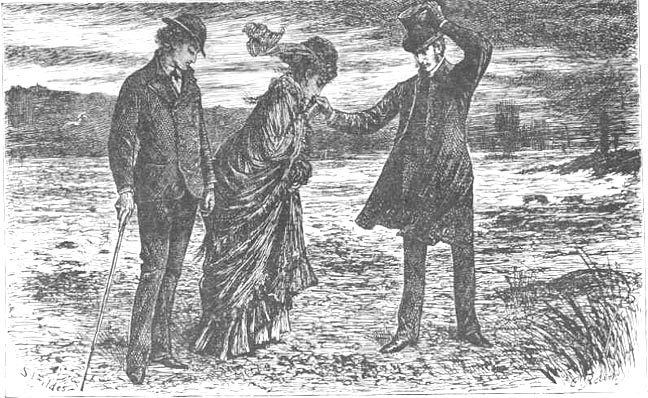Jasper sprang up in a delirious state
Harold Hume Piffard
circa 1900
12 cm high by 7.7 cm wide (4 ⅝ by 3 inches)
Charles Dickens's The Mystery of Edwin Drood, facing p. 129.
Scanned image and text by Philip V. Allingham.
[Victorian Web Home —> Visual Arts —> Illustration —> Charles Dickens —> Harold Hume Piffard —> Mystery of Edwin Drood —> Next]
Jasper sprang up in a delirious state
Harold Hume Piffard
circa 1900
12 cm high by 7.7 cm wide (4 ⅝ by 3 inches)
Charles Dickens's The Mystery of Edwin Drood, facing p. 129.
Scanned image and text by Philip V. Allingham.
[You may use this image without prior permission for any scholarly or educational purpose as long as you (1) credit the person who scanned the image and (2) link your document to this URL in a web document or cite the Victorian Web in a print one.]
Jasper sprang up in a delirious state — Harold Hume Piffard's second lithograph for Charles Dickens's The Mystery of Edwin Drood in the Collins Pocket Edition, referencing page 132. [Click on the image to enlarge it.]
[Crisparkle] debated principally whether he should write to young Drood, or whether he should speak to Jasper. The consciousness of being popular with the whole Cathedral establishment inclined him to the latter course, and the well-timed sight of the lighted gatehouse decided him to take it. “I will strike while the iron is hot,” he said, “and see him now.”
Jasper was lying asleep on a couch before the fire, when, having ascended the postern-stair, and received no answer to his knock at the door, Mr. Crisparkle gently turned the handle and looked in. Long afterwards he had cause to remember how Jasper sprang from the couch in a delirious state between sleeping and waking, and crying out: “What is the matter? Who did it?”
“It is only I, Jasper. I am sorry to have disturbed you.”
The glare of his eyes settled down into a look of recognition, and he moved a chair or two, to make a way to the fireside.
“I was dreaming at a great rate, and am glad to be disturbed from an indigestive after- dinner sleep. Not to mention that you are always welcome.”
“Thank you. I am not confident,” returned Mr. Crisparkle, as he sat himself down in the easy-chair placed for him, “that my subject will at first sight be quite as welcome as myself; but I am a minister of peace, and I pursue my subject in the interests of peace. In a word, Jasper, I want to establish peace between these two young fellows.”
A very perplexed expression took hold of Mr. Jasper’s face; a very perplexing expression too, for Mr. Crisparkle could make nothing of it. [Chapter X, "Smoothing the Way," pp. 132-133]
Having secured Neville's promise to be reconciled to Edwin Drood if his antagonist of the previous night meets him half-way in an apology, the Rev. Septimus Crisparkle now stops at Jasper's bachelor quarters above the cathedral gatehouse. His hope is that Jasper, witness to the altercation, may assist in the reconciliation of the adversaries, both of whom may yet prove intransigent. The choirmaster's delirious state and his glaring eyes disturb the even-tempered clerical visitor, as he long afterward had cause to remember. Thus, Dickens signals that something about Jasper's disturbed demeanour strikes Crisparkle as unsettling. The illustration showing the moment of Jasper's suddenly rising from his couch from his after-dinner nap anticipates the reader's encountering this incident in the letter-press. Although fully dressed, Jasper stares at his visitor as if deranged or disoriented, putting his hand to his head and bracing himself. Crisparkle studies Jasper dispassionately, unsure as to his host's mental and emotional state. His topcoat is still fully buttoned, and he holds the hat he has just removed in entering from the postern stairs, presumably immediately behind him. The rich satin of the elegant couch and the oil painting above it are class markers, as are his respectable jacket, tie, and shirt, all suggesting Jasper's taste, vocation, and income.

Above: Luke Fildes's earlier illustration emphasizes the mediating influence of the Minor Canon in Mr. Crisparkle Is Overpaid (June 1870).
Dickens, Charles. The Mystery of Edwin Drood and Other Stories. Illustrated by Sir Luke Fildes, R. A. London: Chapman and Hall Limited, 193, Piccadilly. 1880.
Dickens, Charles. The Mystery of Edwin Drood and Other Stories, illustrated by Harold Hume Piffard. LOndon & Glasgow: Collins' Clear-Type Press, circa 1904.
Created 28 June 2022
